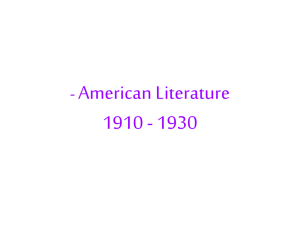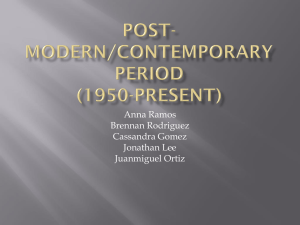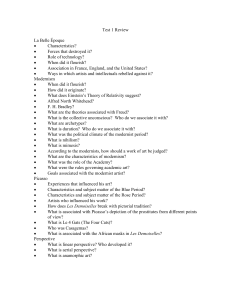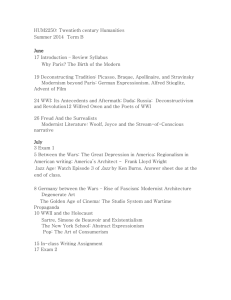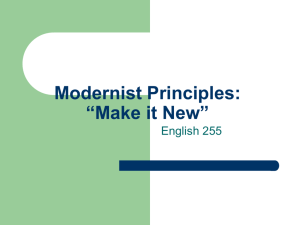Modernism Revisited
advertisement
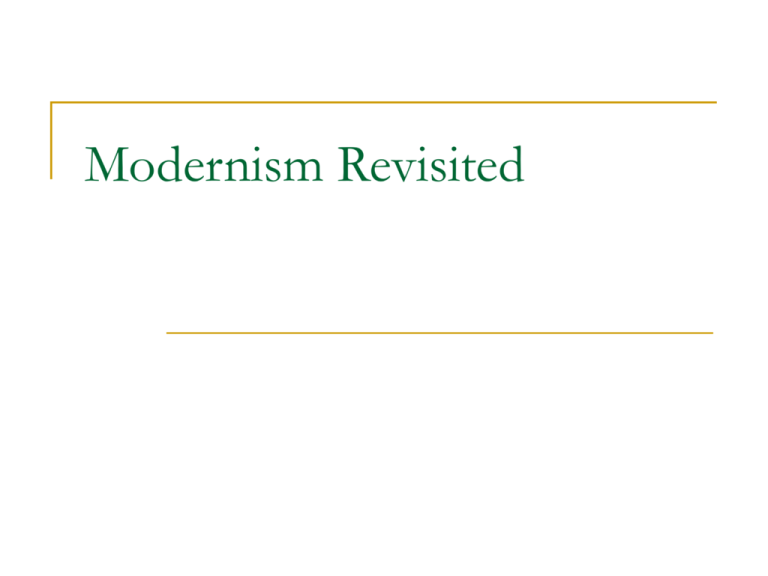
Modernism Revisited The Definitive Statement of the American Myth: F. Scott Fitzgerald’s The Great Gatsby The Great Gatsby closes with Nick mournful, ecstatic mediation on America and its promises. In the final pages of the novel, Fitzgerald alludes to the sweep of American history that appears in the landscape itself. He evokes the fresh virginal country that Dutch sailors saw, the “orgastic” wonder it conveyed – thus reinforcing the magic of the American promise. But this promise has been betrayed. The ideals that gave meaning to American life Middle class ideals of thrift The Protestant work ethic Self-reliant perseverance have been tragically betrayed. Still, Americans continue to strive for them, for some past Romantic ideal of Americanism while we remain hopelessly rooted in a compromised present. But the present is “no matter” we continue to reach for those “platonic” principles regardless of the moral, spiritual landscape, “like boat’s against the current.” We reach out because doing so, gives us tragic grandeur. America will always reach out for the green light. America Looks in the Mirror Like Gatsby’s “Platonic conception of himself”, Americans always thought of themselves in the Puritan ethic: as a people divinely chosen, morally sound, and imbued with a restless and ceaseless sense of optimism. By the sheer force of our shared background, our will, our unique spirit – our people - there was nothing we couldn’t do, no land we could not conquer, no challenge we could not endure.. History at the turn of the century and through 1945 would shake the foundations of American identity. If Literary Nationalism was America’s obedient school boy, if Romanticism was it’s rebellious teenager, then Modernism was its soul-searching early adulthood. Value Differences in the Modern World Pre-Modern World Modern World (Early 20th Century) Ordered Chaotic Meaningful Futile Optimistic Pessimistic Stable Fluctuating Faith Loss of faith Morality/Values Collapse of Morality/Values Clear Sense of Identity Confused Sense of Identity and Place in the World You Will Recall That Modernism was Influenced by Multiple Factors Intellectual currents Charles Darwin Sigmund Freud Albert Einstein World War I – new ways to kill, death on a massive scale The Russian Revolution of 1917 (Communism) New products and technologies The movies and movie culture Prohibition The Harlem Renaissance The new role of women The Modernist Temper Result on American Life Loss of faith in government Loss of faith in business Loss of faith in God Loss of faith in peers and elders Rejection of tradition NEW NEW NEW (“Keep it New” – the “usable past”) Definitions of success Definitions of gender roles Definitions of morality (amorality) Definitions of values The Modernist Timeline The period that began in chaos and commotion in 1915 continued on the same path until 1945. Modernism marks one of the most eventful, colorful, exhilarating, tragic, prosperous and poverty-stricken phases of the American experience. Bookended by two of history’s most Modernist Literature Theodore Dreiser’s Sister Carrie, published in 1900, set the tone for Modernist sensibilities. The narrative of a poor women who “does what she must” to overcome her circumstances is indeed a tale of success, but it is a success without affirming the conventional formula that virtue will be awarded and vice will be punished (anti-Horatio Algier classic American archetypes of hard work = wealth and honor). It dealings are more the stuff of negotiations. Likewise, the landscape of The Great Gatsby is populated by characters constantly “on the make”, ambitious for money, or of questionable character. Even the protagonist, who is described in unrestrained Romantic proportions by a moral narrator, is later revealed as a crook and a liar. Gone was the Romantic notions of the nineteenth century – the icons and heroes who taught us lessons of love and goodness. Against a backdrop of ambiguity emerges artistic expressions that are equally ambiguous, profoundly questioning, deeply focused on the role of the individual The Influences of Freud and Karl Marx on Modernist Literature… Modernist writers concerned themselves with the inner being more than the social being and looked for ways to incorporate these new views into their writing. Modernist writers looked inside themselves for their answers instead of seeking truth, for example, through formal religion or the scientific presuppositions that realism and naturalism rested upon. Marxism instructed even non-Marxist artists that the individual was being lost in a mass society. Though Marx analysis of human behavior opposed that of Freud, both seemed to suggest a kind of predestination or determinism seemed better able to explain the terrible things that were happening in the twentieth century. Some modern writers believed that art should celebrate the working classes, attack Capitalism, and forward revolutionary goals, while others believed that literature should be independent and non-political. Shifts in the Modern Nation from country to city from farm to factory from native born to new citizen introduction to “mass” culture (pop culture) continual movement split between science and the literary tradition (“science vs. letters”) The Spirit of Modernist Literature Conviction that the previously sustaining structures of human life, whether social, political, religious, or artistic, had been either destroyed or shown up as falsehoods or fantasies. Therefore, art had to be renovated. Modernist writing is marked by a strong and conscious break with tradition. It rejects traditional values and assumptions. “Modern” implies a historical discontinuity, a sense of alienation, loss, and despair. It rejects not only history but also society. Poetry tended to provide pessimistic cultural criticism or rejects social issues altogether. Writers exhibited a skeptical, apprehensive attitude toward pop culture; writers criticized and deplored its manipulative commercialism. Literature, especially poetry, becomes the place where the one meaningful activity, the search for meaning, is carried out; and therefore literature is, or should be, vitally important to society. Imaginative vision is thought to give access to an ideal world, apart and above reality, or to contain alternative, higher values than those reigning in the statehouse and the marketplace, which could enrich life. Modernists believed that we create the world in the act of perceiving it. Characteristics of Modernist Writing A movement away from realism into abstractions A deliberate complexity, even to the point of elitism, forcing readers to be well-educated to read these works A high degree of self-consciousness Questions of what constitutes the nature of being A breaking with tradition and conventional modes of form, resulting in fragmentation and bold, highly innovative experimentation A variety in content because with a stable external world in question, subjectivity was ever more valued and accepted in literature Along with the social realist and proletarian prose of the 1920s and 1930s came a significant outpouring of political and protest poetry. Modernist Techniques The modernists were highly conscious that they were being modern—that they were “making it new”—and this consciousness is manifest in the modernists’ radical use of a kind of formlessness. Collapsed plots Fragmentary techniques Shifts in perspective, voice, and tone Stream-of-consciousness point of view Associative techniques Writer’s of the Modernist Period Sherwood Anderson Born in 1876, he grew up in a large, working class family that struggled to make ends meet. He met a wealthy woman, got married and started a family. Anderson rose through the ranks of a mail order company and eventually became the owner of a small factory. In 1912 he suffered a legendary breakdown that changed his life dramatically. Anderson vanished for four days and was eventually found wandering in a cornfield. When he got his wits back, he decided to leave his family to pursue a writer’s life. Death in 1941 – the ultimate modernist joke –on the eve of a trip to South America he was quaffing martinis when he accidentally swallowed a toothpick. By the time he reached the Panama Canal, he was on his deathbed. Anderson Legacy Regionalist, realist, naturalist, prose stylist, primitivist, fictional Freudian, the American D. H. Lawrence, such are some of the labels that have been attached to Sherwood Anderson, with none quite fitting. Categorizing him has been problematic partly because critics have recognized only occasionally that his genius resides in the short story rather than in the novel or autobiography Almost everyone has agreed that his masterpiece is Winesburg, Ohio, a collection of 23 stories published in 1919, but beyond that, opinions have varied. It is now reasonably clear that Anderson was an innovator, making breakthroughs, particularly in short fiction, in form, subject matter, style, and characterization. Anderson was a major influence on the generation of American writers who came after him. These writers included Ernest Hemingway, F. Scott Fitzgerald, and William Faulkner. Anderson thus occupies a place in literary history that cannot be fully explained by the literary quality of his work. Anderson’s Work He published his first novel, Windy McPherson’s Son, in 1916. More novels followed, but he is most remembered for his collection of short stories known as Winesburg, Ohio. Anderson loved to write about “grotesques.” That was his way of describing people who are undermined by their own illusions or false dreams. His work gained the respect and the scorn of some of the biggest writers and critics of the time. H.L. Mencken said he was “America’s most distinguished novelist.” Ernest Hemingway lampooned him. Anderson’s Style Prose style derived from everyday speech, influenced American short story writing between World Wars I and II. Anderson was one of the first American writers to use modern psychological insights, especially those of the Austrian psychiatrist Sigmund Freud. Seen in “the grotesques” He pioneered and "open form," in which plot was less important than expression of mood and character, influential to Hemingway and Faulkner. Anderson on his Work… “What was wanted I thought was form, not plot, an altogether more elusive and difficult thing to come at.” “It is my own language, limited as it is. I will have to learn to work with it. There was a kind of poetry I was seeking in my prose, word to be laid against word in just a certain way, a kind of word color, a march of words and sentences, the color to be squeezed out of simple words, simple sentence construction." Anderson Stats GENRE: New Realism (Naturalism) – no one fully agrees Rearranged time sequence (à la Ambrose Bierce, “…Owl Creek Bridge”) Concentrated on uneventful but emotionally compelling aspects of daily existence (à la W.E.B. Du Bois, “On the Meaning of Progress”) Wrote simple, direct sentences Transferred his point-of-view to outside observers Stresses the dominance of form over content, and he sought to write fiction that was distinct from life (purposely un-real) Many subsequent writers, such as Hemingway and Faulkner, were influenced by his style. Focus: “Brother Death On the surface, “Brother Death” appears a story of family dynamics, the sometimes stressed and complex relationships between the a married couple, between parents and children, between siblings. But the piece is an ALLEGORY of a force gripping and forceful during the Modernist period. Recall that an allegory is an extended metaphor. It is a narrative that functions on both a literal and figurative level. A sort of story within a story Literary features: Increase in symbolism Emphasis of mood and character over plot Psychology (a burgeoning science) What do the tree stumps represent? What do Don and Ted represent? Psychological warfare: Struggle for power Stream of consciousness (i.e., written equivalent of a character’s thought processes) Abrupt insertion of italicized dialogue that is actually unspoken Themes in “Brother Death” Old Aristocracy vs. Nouveau Riche (Greys vs. Aspinwalhs) Struggle for Power (John vs. Don) Emerging Feminism (Mary Grey) Literal Death vs Spiritual /Emotional Death (Ted vs. Don) Social classes in America (symbolism) Beauty in modern life (the oaks) Young vs. Old Guiding Questions 1. 2. 3. 4. 5. How do Ted and Mary combine the innocence of childhood with maturity of adulthood? Why are the mother and father working against each other? In what ways are their backgrounds different? What do the trees represent to Louise AspinwahlGray? To John Grey? To Ted and Mary? To Don Grey? What statements does this story make about power? How can statements about power be applied to the Modernist world?
